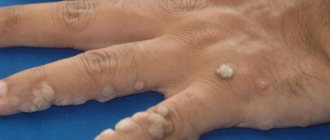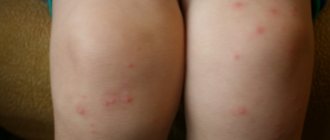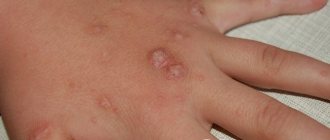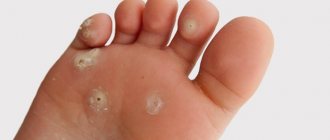Anal herpes is considered a manifestation of the genital form of herpes infection.
One of the most painful forms of viral damage to the skin and mucous membranes is characterized by a chronic recurrent course and dangerous consequences: anal fissure, proctitis. Timely and complete treatment reduces the likelihood of complications.
Papillomas in the anus
Papilloma can form anywhere in the human body, and the anus is no exception. The formation of anal papillomas is a fairly common problem. Since in such cases papillomas form in intimate places, most people prefer not to rush to see a doctor.
Papillomas in the anus often indicate that the same type of formation exists in the human intestine. However, at the early stage of their appearance, papillomas are invisible. Therefore, the resulting anal papilloma is not always the initial stage of a developing disease.
Benign neoplasms such as papillomas can begin to grow rapidly. If there is no effective treatment, as a result of the fusion of processes, the formation of a large tumor of malignant etiology is possible. Thus, by delaying treatment for this serious disease, people do not always understand that it can threaten their lives.
Clinical manifestations
New growths around the anus may be a reason to visit a proctologist.
Usually the patient does not experience pain, burning or discomfort, but may simply discover some kind of formation in the anal area during hygiene measures. Perianal skin folds significantly complicate the process of personal hygiene. These cosmetic defects do not cause any immediate harm to health; they do not interfere with the emptying of the rectum and do not impede body movements. However, there are rare situations when, when pathogenic microbial flora enters, the fimbria become inflamed - itching, pain and slight bleeding appear. The photo from the archives of proctologists shows hyperemia and swelling of the skin around the anus, enlargement and redness of the folds. In severe cases, when the fimbriae are damaged and infection enters the wound, tissue necrosis or the development of paraproctitis occurs.
Sometimes fimbriae can periodically make themselves felt with unpleasant sensations, then subside. Typically, such a wave-like course occurs in patients with concomitant pathology of the rectum (inflammatory diseases, internal hemorrhoids, anal fissure, fistulas). At the same time, there are other characteristic manifestations of chronic pathology. Do not forget about colon and rectal cancer, which can exist for a long time without any symptoms.
Fimbriae discovered by chance should alert the patient and be a reason to contact a proctologist to conduct an appropriate examination of the anus, rectum or other parts of the intestine in order to exclude possible anorectal pathology.
Most patients perceive these defects as an aesthetic inconvenience (the photo shows how ugly the anus looks with shapeless skin folds on a young woman). Harm is caused to a person's psychological status. First of all, a full-fledged personal life is disrupted - a person feels awkward in the nude and is in constant tension during intimacy, which affects general well-being. Most of all, women who turn to a proctologist for help and ask to solve this cosmetic problem in any way show concern about this. Meanwhile, fimbria are a signal of possible trouble in other parts of the colon.
Types of papillomas in the anus
Anal papillomas are most often localized near the anus itself.
Education can be:
- multiple or single processes of small size;
- large single shoots;
- a large process, which is formed as a result of the fusion of numerous growths.
The appearance of the papilloma may resemble a wart.
Differences between papilloma and wart:
- there is a thin leg (a wide base is very rare);
- rough, uneven, folded or lumpy top layer;
- sometimes has a peaked and sharp tip;
- color: from white (light flesh) to dark brown, almost black.
Papillomas in the anal area can be located:
- around the anus;
- in the anus;
- in the rectum.
Diagnosis of growths formed in the rectum is more problematic. If papillomas spread to the rectum, treatment of the disease should not be delayed. Large papilloma located in the colon can cause constipation.
Treatment of perianal dermatitis in adults
Treatment of perianal dermatitis is based on external treatment of the affected areas and, if necessary, the use of medications orally. This comprehensive treatment promotes rapid recovery. Often, for faster healing, local antiseptic preparations with the addition of zinc (Dexpanthenol, etc.) are used.
Most often, perianal dermatitis is treated with the following antibacterial drugs:
Quite often, Triderm is used in the treatment of dermatitis, which has earned positive reviews from patients. However, it should be borne in mind that Triderm can cause intolerance, manifested by allergic rashes on the face, limbs, etc., which is also confirmed by reviews. In addition, Triderm should not be used by children under 2 years of age or pregnant women.
Symptoms of dermatosis provoked by BACTERIAL INFECTION, in addition to antibacterial ointments, are relieved with a solution of brilliant green, blue or Fukortsin.
If the cause of dermatitis is ENTEROBIOSIS, anthelmintics are prescribed:
Perianal dermatitis, as a rule, requires the use of antihistamines (Claritin, Zodak, Loratadine, etc.). These products effectively relieve swelling and itching in the anal area. If it is impossible to neutralize the symptoms of dermatitis with local medications, the doctor may prescribe antimycotic and antibacterial therapy.
The most commonly prescribed rectal medications are:
DOLOPROCT. This cream is used rectally, 2 times a day for 1-2 weeks. It reduces the inflammatory-allergic reaction, while simultaneously relieving swelling and pain.
AUROBIN. Ointment for rectal use is recommended for patients to neutralize the inflammatory process, relieve burning and itching, as well as for rapid healing.
OLESTHESIN. This drug is available in the form of rectal suppositories. Assigned 2 rubles. during the day for a course of 10-12 days.
If the diagnosis of perianal dermatitis has revealed the mycotic nature of the development of the disease, Candide, Clotrimaxozole, Nizoral, Exoderil, etc. are prescribed.
IN SEVERE DEVELOPMENT OF PERIANAL DERMATITIS, external glucocorticosteroids (Prednisolone, Hydrocortisone, etc.) can be prescribed. The weakest of this group of drugs is Hydrocortisone. However, it should be remembered that, despite the fact that the drug has a milder effect, it has the same contraindications as all drugs in this group. In addition, hydrocortisone should not be used in children under 2 years of age.
AT HOME you can use herbal baths. For anal fissures and exacerbation of hemorrhoids, it is recommended to administer suppositories cut from raw peeled potatoes. Patients with a weakened immune system are advised to take a course of vitamin therapy. In addition, physiotherapy using ultrasound waves, laser therapy and magnetic therapy are recommended.
It must be remembered that the development of perianal dermatitis can be avoided by performing basic preventive measures (wearing natural fabrics, timely sanitation of chronic foci of inflammation, personal hygiene). In addition, if the first unpleasant manifestations occur, it is recommended to consult a proctologist and dermatologist.
THE ARTICLE IS IN THE RUBRIC - diseases, dermatitis.
SHARE YOUR EXPERIENCE, LEAVE YOUR COMMENT ON THE ARTICLE - “Photo and treatment of perianal dermatitis”
Good evening! I was first diagnosed with hemorrhoids, I treated it, then dermatitis and they said that I need to go to a dermatologist, we don’t have one in the clinics, they send everyone to the local dermatologist, he is not qualified there, I haven’t worked since the summer of this year because of this disease tell me where to go, where it is in Kemerovo.
Hello Olga. You can find a dermatologist in Kemerovo, for example, using this site https://prodoctorov.ru/kemerovo/dermatolog/
Add a comment Cancel reply
Copyright © 2015-2019 Allergy. The materials on this site are the intellectual property of the owner of the Internet site. Copying information from this resource is permitted only if you provide a full active link to the source. Before using the site materials, consultation with a doctor is required.
Related posts:
- Discolored moles on the body
- Decaris for papillomas
- Plot for warts on hands
- Who removed papillomas forum
01 Aug 2020 94
Causes of papillomas in the anal area
The cause of anal papillomas is the presence of the human papillomavirus (HPV) in the body. 80% of people have HPV, but it may not appear immediately after infection. It is in a "sleeping" state.
Papillomas, as a rule, begin to actively form against the background of a weakening of the protective functions of the human body, which are caused by:
- exacerbation of the disease;
- severe stress;
- non-compliance with nutrition rules.
HPV can “wake up” and cause growths to appear if:
- decreased immunity (as a result of exacerbation of the disease or pregnancy);
- the person is under stress (physical or psychological);
- a course of chemotherapy is being carried out;
- hormonal levels change due to medications;
- a woman uses an IUD as a method of preventing unwanted pregnancy.
Routes of infection
When the papilloma virus enters the human body, the lower layers of the epidermis become its localization site. The incubation period of the disease ranges from a week to several years.
HPV is detected in the mucous membrane and skin of a person, without affecting other organs. Once activated, HPV begins to multiply rapidly. Mature cells enlarge and move towards the surface of the skin. This is how growths are created. After this, a person can infect another, he is a carrier of the disease.
Transmission routes
Transmission of human papillomavirus occurs through sexual intercourse with an HPV carrier. It is important to remember that known methods of birth control cannot provide 100% guarantee of protection, since the human papillomavirus can penetrate the mucous membranes and skin of a person.
In addition, a damaged papilloma may be contagious , since the blood released from it is infected and contains HPV. This can happen due to the fact that the skin of a person’s intimate parts is more delicate and thin, and is more easily susceptible to infection.
It is not particularly difficult for the virus to penetrate the delicate tissues of a person’s intimate parts. The more often and more intensely the contact with an infected person occurs, the higher the risk of acquiring HPV.
Symptoms of papillomas in the anal area
In rare cases, the appearance of anal papillomas is asymptomatic.
But for most people suffering from growths in the anus, the following unpleasant sensations are typical:
- constant humidity;
- burning or itching pain;
- severe itching;
- pain during bowel movements;
- bloody discharge from the anus.
Regardless of the location of papillomas, they cause a lot of discomfort and pain to a person due to:
- injuries as a result of active movements;
- wearing clothes;
- meeting the natural needs of a person (damage to formations from feces during bowel movements).
Even if the growths do not manifest themselves in any way, and the infected person does not feel any unpleasant symptoms, treatment of the disease should begin immediately after detection of papilloma on the body.
Causes for concern
If a lump is accidentally detected in the anus, there are no other complaints from the patient and indications of possible causes, initial independent observation is allowed. Over the course of one to two weeks, it is necessary to eliminate all situations associated with stagnation of blood in the pelvis:
- make nutritional adjustments - exclude hot, spicy foods, coffee, alcohol, fatty foods, fast food;
- normalize stool - avoid constipation or diarrhea;
- avoid heavy lifting;
- increase physical activity during sedentary work;
- Do not wear tight clothing or chafing synthetic underwear.
If a ball appears near the anus, you should consult a proctologist
If the measures taken are enough for the lump to shrink or disappear, then this lifestyle should be made the norm. Most often this situation happens with hemorrhoids. If there is no effect from the work performed or if the condition worsens, you should immediately consult a doctor for examination, to find out the cause, and to choose treatment tactics.
The ball near the anus should cause concern; it is large in size, complicates the process of bowel movement, causes pain and inconvenience when walking or sitting, and bleeds.
These are usually more serious situations than hemorrhoids. The presence of accompanying symptoms also gives reason to contact a specialist as soon as possible.
Similar diseases
Often people find various formations on their body and think that they are papillomas. However, this is not always the case. The formations that appear in overweight people are called soft fibroids of the skin. They may be in folds of skin or in the armpits.
These are benign formations associated with metabolic disorders or resulting from mechanical influences. Skin fibroids most often appear due to changes in a person’s hormonal levels. They do not degenerate into malignant tumors, but can increase in size and number.
You might be interested! Why are papillomas on the head of the penis dangerous and how to treat them?
Scaly rashes:
- — Dermatophytosis of the trunk (dermatophytosis or dermatomycosis is a fungal infectious disease of the skin).
- — Candidiasis (a fungal disease caused by fungi of the genus Candida).
- - Subacute itchy dermatitis (dermatitis is an inflammation of the skin, subacute - the term means that the disease progresses faster than chronic, but does not become acute).
- — Psoriasis (a chronic skin disease of unknown origin, manifested by pink-red spots, plaques, covered with white, easily peeling scales).
Which doctor should I contact?
Which medical specialist should be contacted when a papilloma is detected depends on the areas of the body where the growths appear.
List of doctors:
- see a dermatologist - papillomas are found on the body;
- see a gynecologist - growths have formed on the female genital organs;
- see a urologist - formations are located on the genitals of men;
- see a proctologist for anal papillomas.
A person who discovers a tumor on any part of his body should visit a local physician , who will correctly identify a specialized medical specialist.
Diagnostic methods
A visit to a specialist and subsequent diagnosis are mandatory not only if papilloma is detected, but also if unpleasant symptoms of the disease appear. Timely diagnosis and correctly prescribed treatment will help avoid the process of degeneration of a benign tumor into a malignant tumor.
Diagnosis of the disease includes the following steps:
- Visual examination and interview of the patient . The results of this stage: establishing a preliminary diagnosis and collecting the necessary data. This is information about a person’s pathologies and chronic diseases, his lifestyle and other factors that influence the correct diagnosis.
- Sigmoidoscopy , which allows you to determine disorders of the epithelial tissue of the anus at the microscopic level. Such a study will provide the doctor with reliable data about the patient’s intestines and help draw up a plan for an effective cure for the disease.
- Cytological examination and biopsy. These tests are necessary to obtain a clear and precise picture of the disease. With the help of these studies, you can determine exactly what kind of virus you are dealing with.
It must be remembered that due to the fact that the occurrence of papillomas is provoked by a virus, these growths may appear again. Therefore, patients who have completed the treatment prescribed by the doctor must be examined regularly.
Methods for treating papillomas in the anus
The most effective method of treating anal growths is complete removal (excision).
This procedure is carried out in various ways:
- laser;
- electrocautery;
- chemical;
- electric knife;
- medical scalping;
- radioactive (therapeutic).
During the procedure for removing papillomas in the anal area (inside and around), all other growths on the patient’s body must also be excised.
In most cases, having removed all papillomas from an intimate place, the patient does not remember this disease. It happens less often that the growths appear again. Then the patient will be prescribed various drugs that activate the body’s protective functions, as well as antiviral agents.
Factors contributing to the reappearance of anal papillomas:
- non-compliance with the recommendations of the attending physician;
- decreased immunity;
- bad habits (smoking, alcohol abuse);
- insufficient personal hygiene;
- Unclean sexual relations.
Treatment at home
Before you begin treatment of papillomas in the anus, you need to evaluate the effectiveness of this method in comparison with traditional medicine.
Here we have already covered the issue of a cure for papillomas on the body.
Advantages of home treatment for anal papillomas:
- plant extracts soften the skin and facilitate easier removal;
- such products cleanse the skin and make it clean and healthy;
- do not form rough scars;
It is important to take basic precautions when treating papillomas at home:
- growths cannot be treated in this way if they are located on mucous membranes;
- It is strictly forbidden to remove papillomas mechanically: tearing off, tearing off, cutting;
- in case of unsuccessful treatment, immediately contact a medical facility.
Treatment of papillomas with cryopharm:
- healthy skin should not be affected;
- need help from another person;
- the product is sold in a pharmacy: impregnated medicinal adhesive tape;
- eliminates growths within three hours;
- The procedure may cause discomfort or pain.
Folk remedies:
- potato juice;
- nettle tincture;
- rosehip decoction;
- celandine juice;
- infusions of plantain or horsetail;
- chaga decoction.
Any of these infusions should be moistened with the affected area of the body several times during the day, and the area around the papilloma should be lubricated with a thick cream. You can also treat the growth with iodine.
Treatment of herpes on the anus
Treatment of anal herpes involves taking medications, local treatment, personal hygiene, and diet.
Since the rash is in an area of constant irritation and the inability to provide an abacterial environment, hygiene is important for recovery.
After each act of defecation, it is necessary to wash thoroughly; in addition, hygiene of the anus is carried out at least 2 times a day. Irrigation of the anus is carried out with a decoction of chamomile and calendula. Warm sitz baths in herbal decoctions are also beneficial.
For successful treatment, stool should not be hard; constipation is excluded. The diet is enriched with fermented milk products, whole grains, bran, vegetables, and fruits.
Local treatment involves the use of antiviral and healing agents. For long-term herpes, the use of antibacterial ointments is indicated.
After personal hygiene, the areas are treated with antiseptics: Chlorhexidine, Miramistin, potassium permanganate solution. After which the erosions are lubricated with antiviral ointments. Use ointments with acyclovir, alpizarin.
Ointments against herpes are used in the first days of the disease. Antiherpetic tablets are also started to be used as early as possible: Acyclovir, Ganciclovir. The later specific antiviral treatment is started, the lower its effectiveness.
To speed up the healing of anal herpes, sea buckthorn oil, rosehip oil, vitamin A, Solcoseryl, and suppositories with methyluracil are applied to the lesions.
For frequent relapses of viral infection, immunomodulators are indicated. Immunity correction is carried out with courses of interferon, Cycloferon, Isoprinosine, Polyoxidonium.
Treatment of a crack comes down to the use of suppositories and ointments. Rectal suppositories Ultra-Proct, Posterizan, Proctosan, Salofalk, and Levomekol ointment effectively relieve pain, itching and inflammation.
Intestinal herpes is long and difficult to treat. Cleansing enemas, antibiotics, painkillers are indicated; for severe inflammation, glucocorticoids are prescribed.
Herpes of the anus and rectum is considered a cause of rectal cancer. Therefore, the treatment of this viral infection should be complete.
Prevention
It has long been known that it is better to prevent the occurrence of a disease than to treat it. Following simple rules will help keep HPV in a “dormant” state throughout your life.
To do this you need:
- observe basic rules of daily personal hygiene, paying special attention to the cleanliness of the genitals and anus;
- have regular and trusted sexual partners (streamline your intimate life), avoid promiscuity;
- try to lead a healthy lifestyle: stop smoking and drinking, eat right;
- be attentive to your health;
- avoid stressful situations;
- constantly monitor the symptoms of the disease;
- follow all recommendations of the attending physician;
- strengthen the immune system.
It is very important that the prevention of anal papillomas is carried out by both sexual partners. It must be remembered that the patient’s attention to his own health will allow him to detect pathology in the early stages and successfully carry out treatment.











